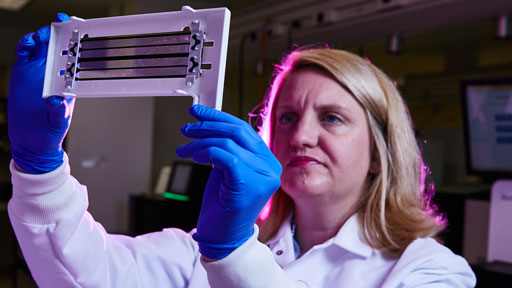
Stephanie A. Morris, Ph.D.
Division Of Genome Sciences
B.A. Wesleyan University
Ph.D. University of North Carolina at Chapel Hill
Biography
Dr. Stephanie Morris joined the National Human Genome Research Institute’s (NHGRI) Extramural Research Program as a program director in 2019. She manages a portfolio of grants focused on high-throughput genomic technology development and functional genomics. She also oversees NHGRI’s Genome Technology program, Centers of Excellence in Genomic Science (CEGS) program, and the Impact of Genomic Variation on Function (IGVF) program. IGVF, launched in 2021, is utilizing emerging experimental and computational genomic approaches to build a catalog of the effects of genomic variation on genome function and phenotypes.
Prior to joining NHGRI, Dr. Morris was a program director in the NIH Office of the Director on the leadership teams responsible for oversight of the Common Fund Molecular Transducers of Physical Activity program and the Somatic Cell Genome Editing program. She joined NIH extramural in 2012 as a program director in the National Cancer Institute's (NCI) Center for Strategic Scientific Initiatives where she was part of the management team for the Alliance for Nanotechnology in Cancer program. While at NCI, she managed a nanomaterials data repository and a portfolio of nanotechnology research awards primarily focused on nucleic acid-based therapeutics. Prior to her graduate studies, Dr. Morris directed an Analytical Ultracentrifugation Facility at the Albert Einstein College of Medicine. Her scientific background is in epigenetics and gene expression and extends to interests in technology development and functional genomics.
Dr. Morris received a B.A. in biology and neuroscience and behavior from Wesleyan University, a Ph.D. in biochemistry and biophysics from the University of North Carolina at Chapel Hill and completed postdoctoral research at NCI in the Laboratory of Receptor Biology and Gene Expression.
-
Biography
Dr. Stephanie Morris joined the National Human Genome Research Institute’s (NHGRI) Extramural Research Program as a program director in 2019. She manages a portfolio of grants focused on high-throughput genomic technology development and functional genomics. She also oversees NHGRI’s Genome Technology program, Centers of Excellence in Genomic Science (CEGS) program, and the Impact of Genomic Variation on Function (IGVF) program. IGVF, launched in 2021, is utilizing emerging experimental and computational genomic approaches to build a catalog of the effects of genomic variation on genome function and phenotypes.
Prior to joining NHGRI, Dr. Morris was a program director in the NIH Office of the Director on the leadership teams responsible for oversight of the Common Fund Molecular Transducers of Physical Activity program and the Somatic Cell Genome Editing program. She joined NIH extramural in 2012 as a program director in the National Cancer Institute's (NCI) Center for Strategic Scientific Initiatives where she was part of the management team for the Alliance for Nanotechnology in Cancer program. While at NCI, she managed a nanomaterials data repository and a portfolio of nanotechnology research awards primarily focused on nucleic acid-based therapeutics. Prior to her graduate studies, Dr. Morris directed an Analytical Ultracentrifugation Facility at the Albert Einstein College of Medicine. Her scientific background is in epigenetics and gene expression and extends to interests in technology development and functional genomics.
Dr. Morris received a B.A. in biology and neuroscience and behavior from Wesleyan University, a Ph.D. in biochemistry and biophysics from the University of North Carolina at Chapel Hill and completed postdoctoral research at NCI in the Laboratory of Receptor Biology and Gene Expression.
Publications
Sanford, JA and the Molecular Transducers of Physical Activity Consortium. Molecular Transducers of Physical Activity Consortium (MoTrPAC): Mapping the Dynamic Responses to Exercise. Cell 2020 181, 1464-1474. [PubMed]
Grodzinski P, Liu CH, Hartshorn CM, Morris SA, and Russell LM. NCI Alliance for Nanotechnology in Cancer ― from academic research to clinical interventions. Biomedical Microdevices 2019 21:32. [PubMed]
Rai P and Morris SA, Eds. Nanotheranostics for Cancer Applications. 1st ed. New York: Springer International Publishing 2018.
Johnson TA, Chereji RV, Stavreva DA, Morris SA, Hager GL, and Clark DJ. Conventional and pioneer modes of glucocorticoid receptor interaction with enhancer chromatin in vivo. Nucleic Acids Research 2018 46, 203-214. [PubMed]
Morris SA, Gaheen S, Lijowski M, Heiskanen M and Klemm JD. Experiences in supporting the structures collection of cancer nanotechnology data using caNanoLab. Beilstein Journal of Nanotechnology 2015 6, 1580-1593. [PubMed]
Powers CM, Mills K, Morris, SA, Gaheen S, Klaessig F, Lewinski N Hendren CO. Nanocuration workflows: establishing best practices for identifying, inputting, and sharing data to inform decisions on nanomaterials. Beilstein Journal of Nanotechnology 2015 6, 1860-1871. [Pubmed]
Dickherber T, Morris SA, and Grodzinski P. NCI investment in nanotechnology: achievements and challenges for the future. Wiley Interdisciplinary Reviews (WIREs): Nanomedicine and Nanobiotechnology, 2015 7(3): 251-65. [PubMed]
Morris SA, Farrell D, Grodzinski P. Nanotechnologies in cancer treatment and diagnosis. Journal of the National Comprehensive Cancer Network 2014 12: 1727-33. [PubMed]
Morris SA, Baek S, Sung MH, John S, Wiench M, Schiltz, RL, and Hager GL. Overlapping chromatin remodeling systems collaborate genome-wide at dynamic chromatin transitions. Nature Structural and Molecular Biology 2014 21: 73-81. [PubMed]
Gaheen S, Hinkal GW, Morris SA, Lijowski M, Heiskanen M and Klemm JD. caNanoLab: data sharing to expedite the use of nanotechnology in biomedicine. Computational Science and Discovery 2013 6: 014010. [PubMed]
Miranda TB, Morris SA, and Hager GL. Complex genomic interactions in the dynamic regulation of transcription by the glucocorticoid receptor. Molecular and Cellular Endocrinology 2013 380: 16-24. [PubMed]
Gupta S, Cheng H, Mollah AK, Jamison E, Morris S, Chance MR, Khrapunov S, and Brenowitz M. DNA and protein footprinting analysis of the modulation of DNA binding by the N-terminal domain of the Saccharomyces cerevisiae TATA binding protein. Biochemistry 2007 46: 9886-9898. [PubMed]
Morris SA, Rao B, Garcia BA, Hake SB, Diaz RL, Shabanowitz J, Hunt DF, Allis CD, Lieb JL, and Strahl BD. Identification of histone H3 lysine 36 acetylation as a highly conserved histone modification. Journal of Biological Chemistry 2007 282: 7632-7640. [PubMed]
Garcia BA, Hake SA, Diaz RL, Kauer M, Morris SA, Recht J, Shabanowitz J, Mishra N, Strahl BD, Hunt DF, and Allis CD. Organism-specific post-translational modification differences in histones H3 and H4. Journal of Biological Chemistry 2007 282:7641-7655. [PubMed]
Keogh M, Kurdistani SK, Morris SA, Ahn SH, Collins SR, Podolny V, Chin K, Punna T, Thompson NJ, Boone C., Emili A, Weissman JS, Hughes TR, Strahl BD, Grunstein M, Greenblatt JF, Buratowski S, and Krogan NJ. Cotranscriptional set2 methylation of histone H3 lysine 36 recruits a repressive Rpd3 complex. Cell 2005 123: 593-605. [PubMed]
Morris SA, Shibata Y, Noma K, Tsukamoto Y, Warren E, Temple B, Grewal SIS, and Strahl BD. Histone H3 K36 methylation is associated with transcription elongation in Schizosaccharomyces pombe. Eukaryotic Cell 2005 4: 1446-1454. [PubMed]
Adhvaryu KK, Morris SA, Strahl BD, and Selker EU. Methylation of histone H3 lysine 36 is required for normal development in Neurospora crassa. Eukaryotic Cell 2005 4: 1455-1464. [PubMed]
Morris S, Ahmad N, Andre S, Kaltner H, Gabius H, Brenowitz M, and Brewer F. Quaternary solution structures of galectins-1, -3, and -7. Glycobiology 2004 14: 293-300. [PubMed]
Takamoto K, He Q, Morris S, Chance MR, and Brenowitz M. Monovalent cations mediate formation of native tertiary structure of the Tetrahymena thermophila ribozyme. Nature Structural Biology 2002 9: 928-933. [PubMed]
-
Publications
Sanford, JA and the Molecular Transducers of Physical Activity Consortium. Molecular Transducers of Physical Activity Consortium (MoTrPAC): Mapping the Dynamic Responses to Exercise. Cell 2020 181, 1464-1474. [PubMed]
Grodzinski P, Liu CH, Hartshorn CM, Morris SA, and Russell LM. NCI Alliance for Nanotechnology in Cancer ― from academic research to clinical interventions. Biomedical Microdevices 2019 21:32. [PubMed]
Rai P and Morris SA, Eds. Nanotheranostics for Cancer Applications. 1st ed. New York: Springer International Publishing 2018.
Johnson TA, Chereji RV, Stavreva DA, Morris SA, Hager GL, and Clark DJ. Conventional and pioneer modes of glucocorticoid receptor interaction with enhancer chromatin in vivo. Nucleic Acids Research 2018 46, 203-214. [PubMed]
Morris SA, Gaheen S, Lijowski M, Heiskanen M and Klemm JD. Experiences in supporting the structures collection of cancer nanotechnology data using caNanoLab. Beilstein Journal of Nanotechnology 2015 6, 1580-1593. [PubMed]
Powers CM, Mills K, Morris, SA, Gaheen S, Klaessig F, Lewinski N Hendren CO. Nanocuration workflows: establishing best practices for identifying, inputting, and sharing data to inform decisions on nanomaterials. Beilstein Journal of Nanotechnology 2015 6, 1860-1871. [Pubmed]
Dickherber T, Morris SA, and Grodzinski P. NCI investment in nanotechnology: achievements and challenges for the future. Wiley Interdisciplinary Reviews (WIREs): Nanomedicine and Nanobiotechnology, 2015 7(3): 251-65. [PubMed]
Morris SA, Farrell D, Grodzinski P. Nanotechnologies in cancer treatment and diagnosis. Journal of the National Comprehensive Cancer Network 2014 12: 1727-33. [PubMed]
Morris SA, Baek S, Sung MH, John S, Wiench M, Schiltz, RL, and Hager GL. Overlapping chromatin remodeling systems collaborate genome-wide at dynamic chromatin transitions. Nature Structural and Molecular Biology 2014 21: 73-81. [PubMed]
Gaheen S, Hinkal GW, Morris SA, Lijowski M, Heiskanen M and Klemm JD. caNanoLab: data sharing to expedite the use of nanotechnology in biomedicine. Computational Science and Discovery 2013 6: 014010. [PubMed]
Miranda TB, Morris SA, and Hager GL. Complex genomic interactions in the dynamic regulation of transcription by the glucocorticoid receptor. Molecular and Cellular Endocrinology 2013 380: 16-24. [PubMed]
Gupta S, Cheng H, Mollah AK, Jamison E, Morris S, Chance MR, Khrapunov S, and Brenowitz M. DNA and protein footprinting analysis of the modulation of DNA binding by the N-terminal domain of the Saccharomyces cerevisiae TATA binding protein. Biochemistry 2007 46: 9886-9898. [PubMed]
Morris SA, Rao B, Garcia BA, Hake SB, Diaz RL, Shabanowitz J, Hunt DF, Allis CD, Lieb JL, and Strahl BD. Identification of histone H3 lysine 36 acetylation as a highly conserved histone modification. Journal of Biological Chemistry 2007 282: 7632-7640. [PubMed]
Garcia BA, Hake SA, Diaz RL, Kauer M, Morris SA, Recht J, Shabanowitz J, Mishra N, Strahl BD, Hunt DF, and Allis CD. Organism-specific post-translational modification differences in histones H3 and H4. Journal of Biological Chemistry 2007 282:7641-7655. [PubMed]
Keogh M, Kurdistani SK, Morris SA, Ahn SH, Collins SR, Podolny V, Chin K, Punna T, Thompson NJ, Boone C., Emili A, Weissman JS, Hughes TR, Strahl BD, Grunstein M, Greenblatt JF, Buratowski S, and Krogan NJ. Cotranscriptional set2 methylation of histone H3 lysine 36 recruits a repressive Rpd3 complex. Cell 2005 123: 593-605. [PubMed]
Morris SA, Shibata Y, Noma K, Tsukamoto Y, Warren E, Temple B, Grewal SIS, and Strahl BD. Histone H3 K36 methylation is associated with transcription elongation in Schizosaccharomyces pombe. Eukaryotic Cell 2005 4: 1446-1454. [PubMed]
Adhvaryu KK, Morris SA, Strahl BD, and Selker EU. Methylation of histone H3 lysine 36 is required for normal development in Neurospora crassa. Eukaryotic Cell 2005 4: 1455-1464. [PubMed]
Morris S, Ahmad N, Andre S, Kaltner H, Gabius H, Brenowitz M, and Brewer F. Quaternary solution structures of galectins-1, -3, and -7. Glycobiology 2004 14: 293-300. [PubMed]
Takamoto K, He Q, Morris S, Chance MR, and Brenowitz M. Monovalent cations mediate formation of native tertiary structure of the Tetrahymena thermophila ribozyme. Nature Structural Biology 2002 9: 928-933. [PubMed]
Last updated: January 23, 2023




